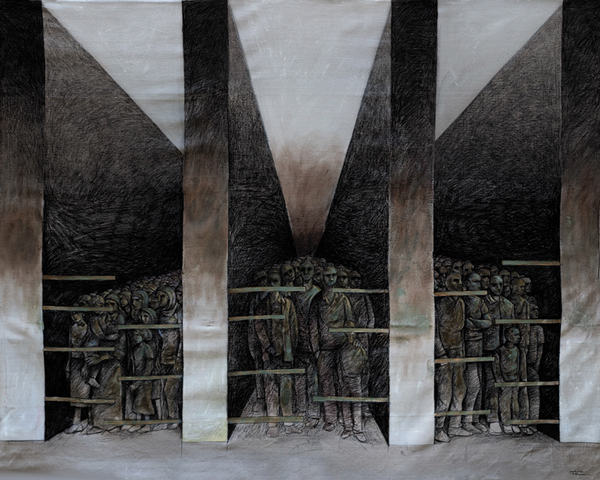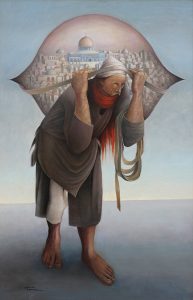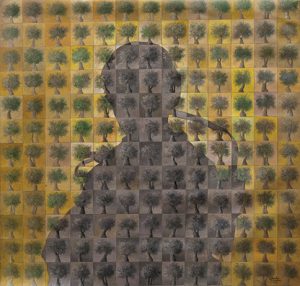 Sliman Mansour is one of the most prominent contemporary Palestinian artists whose works have become part of the collective memory and identity of Palestinians. His practice spans more than four decades in which he has distilled Palestinian experiences through the prism of his canvas, providing important reflections on the changes that have impacted Palestine in its recent history. Throughout his career, Mansour has created iconic images that have become a cornerstone of Palestinian visual culture, such as The Camel of Hardships (1974), which depicts a porter wandering in an empty landscape and carrying Jerusalem on his back, an iconic representation of the loss of a homeland.
Sliman Mansour is one of the most prominent contemporary Palestinian artists whose works have become part of the collective memory and identity of Palestinians. His practice spans more than four decades in which he has distilled Palestinian experiences through the prism of his canvas, providing important reflections on the changes that have impacted Palestine in its recent history. Throughout his career, Mansour has created iconic images that have become a cornerstone of Palestinian visual culture, such as The Camel of Hardships (1974), which depicts a porter wandering in an empty landscape and carrying Jerusalem on his back, an iconic representation of the loss of a homeland.

Born in 1947 in Birzeit, Palestine, Mansour pursued art throughout his teenage years. Having planned to continue his academic education at the Chicago Art Institute, the events of 1967 prompted him to remain in Jerusalem, where he was accepted into the Bezalel Art Academy. Throughout his years of study he experienced the dichotomy of living in East Jerusalem while studying in West Jerusalem.

Sliman Mansour was one of the key artists in the establishment of The League of Palestinian Artists who were at the forefront of creating and promoting Palestinian art under occupation, organizing exhibitions, and encouraging talented artists. Visual art played an important role in the representation of national and cultural identity at a time when the Palestinian flag – even the mere representation of its colors – was banned along with all other articulations of Palestinian identity. Mansour’s paintings have been confiscated by Israeli soldiers, and he was held in custody for his work. His art has explored the representation of Jerusalem’s Old City and the iconic place it holds in Palestinian culture; his images of the motherland with canvases that depict monumental women in Palestinian costume embracing Jerusalem or working in the landscape, show stoic figures representing the steadfastness of a people.

Mansour was co-founder and director of Al Wasiti Art Centre in Occupied East Jerusalem, an important institution that showcased Palestinian artwork. Created by locals and members of the diaspora, the center was forced to close permanently in 2001, during the second Intifada. Furthermore, Mansour was one of the founders and a board member of The Palestinian Association of Contemporary Art, established in 2004, and of their landmark project The International Academy of Art, Palestine, that offers a bachelor’s degree in contemporary visual art. Mansour has taught regularly at Al-Quds University in Abu Dis, sat on numerous juries for art competitions, received a major prize at the Cairo Biennale, 1998, and was recognized for his life-long and distinguished contribution to Palestinian art and culture by President Mahmoud Abbas. His work is held in private collections across the world and at museums that include The British Museum (London), Mathaf (Qatar), The Guggenheim Museum (New York), and the Institut du Monde Arabe (Paris).

